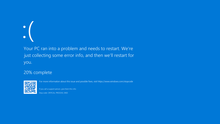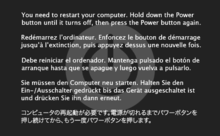Screen of death
Appearance
(Redirected from GSoD)
This article needs additional citations for verification. (June 2011) |

In computing, a screen of death, colloquially referred to as a blue screen of death (named after the infamous screen of death in Microsoft Windows), is an informal term for a type of a computer operating system error message displayed onscreen when the system has experienced a fatal system error. The fatal error typically results in unsaved work being lost and often indicates serious problems with the system's hardware or software. These error screens are usually the result of a kernel panic, although the terms are frequently used interchangeably. Most screens of death are displayed on an even background color with a message advising the user to restart the computer.
Notable examples
[edit]


- The Blue Screen of Death (also called BSoD, or stop error) is a common name for a screen displayed by the Microsoft Windows operating system when a critical system error occurs. By far, this is the most famous screen of death.
- Black Screens of Death are used by several systems: One is a failure mode of Windows 3.x. One appears when the bootloader for Windows Vista and later fails. Also in Windows 11 previews the Blue Screen of Death was changed to black.[1]
- A Green Screen of Death is a green screen that appears on a TiVo with a message that includes the words "the DVR has detected a serious problem and is now attempting to fix it" or "A severe error has occurred". Its appearance often means that the hard drive is corrupted and it will attempt to clean up, check, and/or repair the TiVo Media File System.[2][3] A Blue Screen of Death on a Windows Insider build appears as green instead of blue, starting with build 14997.[4]
- The Purple Screen of Death is used by VMware ESXi, a server virtualization product by VMware. It is displayed in the event of a fatal kernel error. The screen provides error codes that can be used for debugging purposes.
- The Red Screen of Death is used primarily by four different systems: One appears in early beta versions of Windows Vista, but it later became a black screen. Another was in Windows 98 beta builds and was caused by an error with the ACPI. It also appears on the Atari Jaguar if there is a loading cartridge error or a pirated cartridge is detected, marked by the roar of a jaguar and a red Atari Jaguar logo on a screen that changes color from black to red. A similar thing happens on the Sega Genesis (also known as Sega Mega Drive) if an incorrect checksum is detected.[5] Lastly, it is shown on the PlayStation 2, 3, and Portable. On the PlayStation 2, the red screen of death bears similarities to the regular startup, such as the pitched-down menu screen audio and its subsequent ambient noises, alongside a faint whistle. After the normal startup, a red screen will appear with a message saying "Please insert a PlayStation or PlayStation 2 format disc". This error can be obtained by inserting a non-compatible disc, e.g. a PC game disc or later Xbox 360 discs. On the PlayStation 3 and PlayStation Portable, a red screen of death appears during a severe error in the console's internals, with the message saying "A serious error has occurred. Contact technical support for assistance" in multiple languages.
- A White Screen of Death appears on several other operating systems, content management systems,[6] and on some BIOS. It can be seen on iOS 7, and also when a white iPhone 5 or later or a white 5th generation iPod Touch screen freezes. Everything on the screen but the back Apple logo turns white.[7]
- A Yellow Screen of Death occurs when an ASP.NET web app finds a problem and crashes.[8][self-published source?]
- A kernel panic is the Unix equivalent of Microsoft's Blue Screen of Death. It is a routine called when the kernel detects irrecoverable errors in runtime correctness; in other words, when continuing the operation may risk escalating system instability, and a system reboot is easier than attempted recovery.
- A Sad Mac is a symbol used by older-generation Apple Macintosh computers, starting with the original Macintosh 128K, to indicate a severe hardware or software problem that prevented startup from occurring successfully. A similar symbol exists for the iPod.
- A Sad Tab is an icon featuring a frowning folder displayed on a tab in Google Chrome when that tab crashes. The symbol shares the face of the Sad Mac.
- The Bomb icon is a symbol that was displayed when a classic Mac OS program crashed. The bomb symbols were also used by the Atari ST line of computers when the system encountered a fatal system error. The number of bombs indicated the exact cause of the error.
- Guru Meditation is the name of the error that occurred on early versions of the Amiga computers when they crashed. It was also used on the Nintendo DS, most commonly seen when using homebrew. (The top screen was black, and the bottom screen was red with white debug font saying "Guru Meditation Error! data abort! [sic]" with some hex addresses below it.)
- Kernel Debugging Land is the name of the Kernel Debugger users of Haiku and BeOS see when a kernel crash happens.
See also
[edit]Wikimedia Commons has media related to Screens of death.
- Kill screen
- Xbox 360 technical problems (Common name for a hardware error is the 'Red Ring of Death')
References
[edit]- ^ Warren, Tom (2021-07-01). "Microsoft's Blue Screen of Death is changing to black in Windows 11". The Verge. Retrieved 2021-08-09.
- ^ Todd W. Carter; Michael Bellomo (2004). How to Do Everything with Your TiVo. McGraw Hill Professional. pp. 245, 246, 344. ISBN 978-0-07-223140-3.
- ^ Krikorian. TiVo Hacks: 100 Industrial-Strength Tips & Tools. O'Reilly Media. 2003. Page 24.
- ^ Warren, Tom (29 December 2016). "Windows 10 testers will now get a Green Screen of Death". The Verge. Vox Media.
- ^ "Sonic HackingWiz Pro - Sonic Retro".
- ^ "[Drupal] "White screen of death" (WSOD) / HTTP Error 500". drupal.org. 2007-07-10. Retrieved 2021-04-19.
- ^ Ulanoff, Lance (2006-09-12). "The Apple iPod's White Screen of Death". PCMag.com. Retrieved 2011-05-23.
- ^ Busoli, Simone (November 15, 2007). "ELMAH - Error Logging Modules And Handlers".
